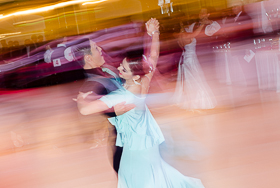IVDC 2013 : The student dance championships
So once again, the great seaside town of Blackpool finds itself overcome with torrents of dancers laden down with bottles of tan, cans of hairspray, and enough energy bars and drinks to fuel a small army. But these are not ordinary Dancesport competitors. These are students, most of whom have only been dancing Ballroom and Latin American for a few months before they compete at the wonderfully decadent Empress Ballroom at the winter Gardens. Sometime in early March, usually before the Easter break, the Inter-Varsity Dance Association (IVDA), the elected governing body behind UK University Dancesport, organise the biggest competition of the year for these students.
As bed and breakfasts up and down the seafront cater to nearly six hundred athletes from thirty-two universities all over the country, you could almost mistake it for any of Blackpool’s dance festivals. This is because even though their training may be short lived, these students take this competition in particular very seriously. The culmination of a semester and-a-bit’s hard work all comes down to the one and a half minutes you spend on the floor, whilst teachers, committee members and friends stand at the side wildly polishing, spraying, sewing, and shouting cheers of encouragement. The atmosphere is electric!
Just to give you some idea of the sheer amount of people competing, the beginners’ first round waltz was danced in five rounds, a semi final and a final. The first round was danced in the Empress Ballroom, after which, all of the beginner heats were danced in the Spanish hall, with the second round of both the waltz and quickstep having fourteen heats each! With each university huddled round a corner of the room, crying out the numbers and names of the competitors they want to progress, you can understand when I say that it is possibly the loudest competition you will ever go to.
As each category nears its end, everyone returns to the Empress Ballroom for the final showdowns between couples. The elation on the faces of beginners as their numbers are called for the semis (and possibly finals) is positively heart-warming. Each one dances their best, every spin turn, chasse, whisk and weave are danced bursting with excitement and exuberance, until the music ends, and all they can do is sit, and wait.
After the ballroom events finish, our attention turns to the ‘Offbeat’ event, where universities enter teams of students with one aim: To perform a group dance piece in any style other than Ballroom or Latin American. Over the next thirty minutes, we see pieces based in jazz, urban, contemporary and even tap. A chance for the committees of the universities, and their members, to express their artistic talents, as well as have fun performing dance styles other than those competed with in Dancesport training. The diversity of the pieces makes for an interesting pre-latin show for the duration of the lunch break.
Come about three in the afternoon we are ready to begin the Latin American rounds, which are run in a similar fashion to the Ballroom rounds (if it ain’t broke…) Whilst the beginners, again, lead off into the Spanish hall, the Empress Ballroom is alive with the motions of Latin American technique. Cha Cha Chas, Rumbas, Sambas, Jives and Paso Dobles ring out from the stage as novices, intermediates, advanced and ex-students battle it out on the dance floor. The furious competition between the universities is most palpable here. For to be a beginner dancer, you must have had under one year of professional training, after this, you must progress to the novice category, where you can remain until you reach a final. This means that any competitor within the higher categories would probably have danced here before. You could excuse the beginners for coming along just for the fun of it, novice’s go in for the glory.
By seven pm the latin rounds are drawing to a close. That would normally signal the end of any other competition, however, three more events will be hosted tonight. We begin with a pairing, non-acrobatic and acrobatic Rock ‘n’ Roll. These competitions see any partnership of any standard pitted against one another with only one rule, have fun! The competition is serious, but the judges are not just looking for technique. Only the wackiest, craziest, loopiest routines (and costumes) danced with never ending amounts of energy and enthusiasm make it through to the final, and that’s just the non-acrobatic version. In the acrobatic version, lifts are allowed, any you like. With girls, and boys, being thrown in the air with the grace of a gymnast, the strength of these dancers is immense.
The final event is one of unity. It requires teamwork, encouragement, and a steady nerve. For any athlete, competing against someone of an obviously higher standard is a dwelling prospect, but it is what is necessary for the team event. Each university competition holds this event slightly differently, however at IVDC, it works as such: Each team comprises of four couples, generally of similar abilities although that is not always the case. Each couple in the team have the same number. One couple from each team dance one dance (either a waltz, quickstep, cha cha cha or jive) and their rankings are calculated at the end of the event, with the highest average ranking team winning first place for their university.
At IVDC, a qualifier round is danced, to assess the level of the team. Each team is then put into either division 1 (dancers with higher level of technique) and division two (dancers with a lower level of technique, generally beginners and novice competitors), with one team winning their respective division. The qualifying round is split from the main competition by a demonstration. This year, that demonstration came from Andrey Sirbu & Alexandra Hixson and Michael Hemera & Lauren McFarlane-Hemera. These two fantastic couples delighted the entire winter gardens with a ten dance display between them, electrifying the audience into a standing ovation for both couples.
As the day draws to a close, so does the competition. With each successful finalist being presented with a trophy to seal their efforts, the universities head back to their places of rest, and, in true student fashion, party on late into the night/ morning.





















